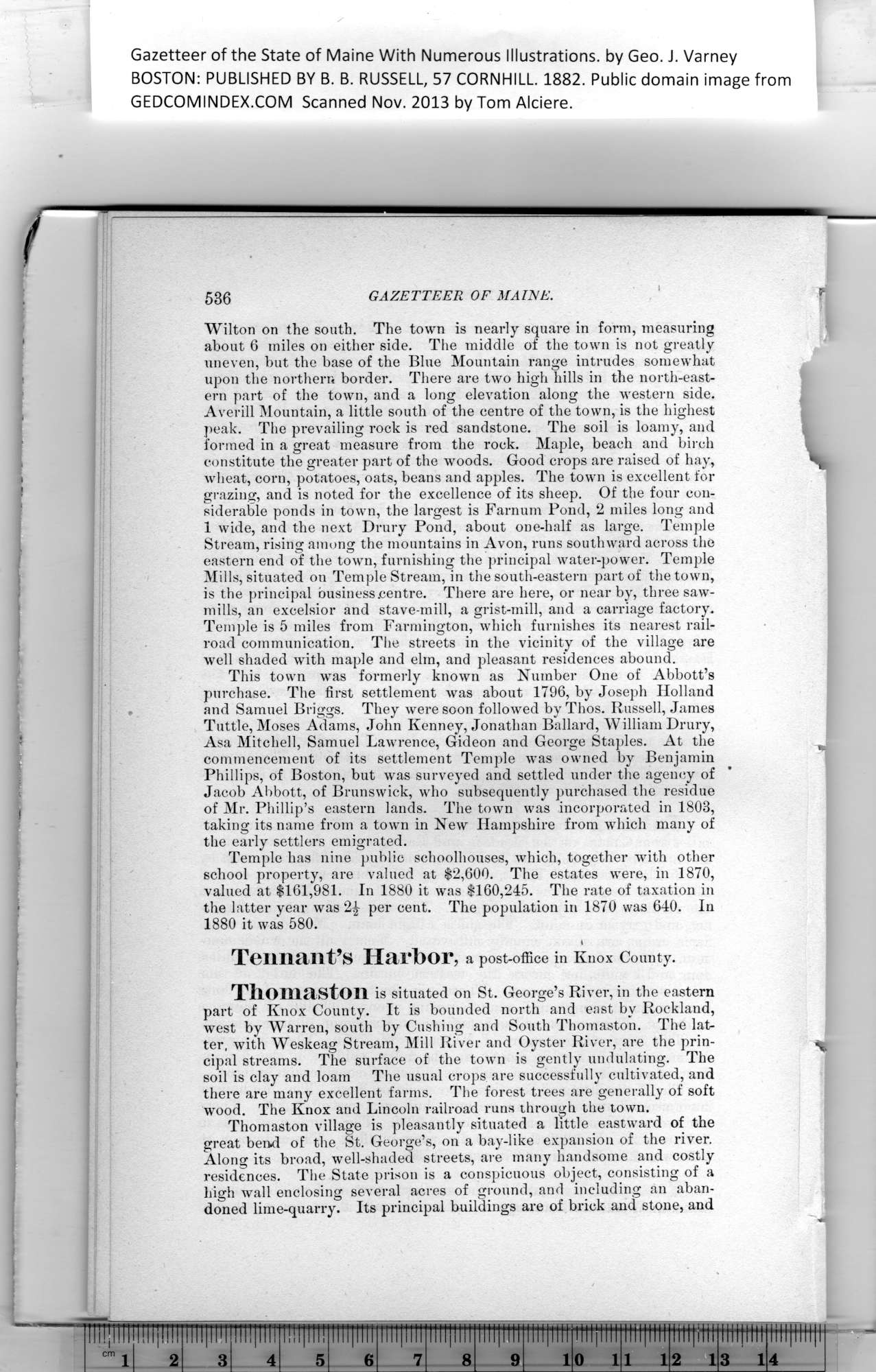|
Gazetteer of the State of Maine With Numerous Illustrations, by Geo. J. Varney
BOSTON: PUBLISHED BY B. B. RUSSELL, 57 CORNHILL. 1882. Public domain image from
i
536 GAZETTEER OF MAINE.
Wilton on the south. The town is nearly square in form, measuring
' ahout 6 miles on either side. The middle of the town is not greatly
uneven, but the base of the Blue Mountain range intrudes somewhat
upon the northern border. There are two high hills in the north-east-
ern part of the town, and a long elevation along the western side.
Averill Mountain, a little south of the centre of the town, is the highest
peak. The prevailing rock is red sandstone. The soil is loamy, and
formed in a great measure from the rock. Maple, beach and birch
constitute the greater part of the woods. Good crops are raised of hay,
i wheat, corn, potatoes, oats, beans and apples. The town is excellent for
' grazing, and is noted for the excellence of its sheep. Of the four con-
siderable ponds in town, the largest is Farnum Pond, 2 miles long and
1 wide, and the next Drury Pond, about one-half as large. Temple
Stream, rising among the mountains in Avon, runs southward across the
eastern end of the town, furnishing the principal water-power. Temple
Mills, situated on Temple Stream, in the south-eastern part of the town,
is the principal business .centre. There are here, or nearby, three saw-
mills, an excelsior and stave-mill, a grist-mill, and a carriage factory.
Temple is 5 miles from Farmington, which furnishes its nearest rail-
road communication. The streets in the vicinity of the village are
well shaded with maple and elm, and pleasant residences abound.
This town was formerly known as Number One of Abbott’s
purchase. The first settlement was about 1796, by Joseph Holland
. and Samuel Briggs. They were soon followed by Thos. Russell, James
Tuttle, Moses Adams, John Kenney, Jonathan Ballard, William Drury,
! Asa Mitchell, Samuel Lawrence, Gideon and George Staples. At tbe
commencement of its settlement Temple was owned by Benjamin
Phillips, of Boston, but was surveyed and settled under the agency of
Jacob Abbott, of Brunswick, who subsequently purchased the residue
j of Mr. Phillip’s eastern lands. The town was incorporated in 1803,
taking its name from a town in New Hampshire from which many of
the early settlers emigrated.
Temple has nine public schoolhouses, which, together with other
school property, are valued at $2,600. The estates were, in 1870,
valued at $161,981. In 1880 it was $160,245. The rate of taxation in
the latter year was 2^ per cent. The population in 1870 was 640. In
1880 it was 580.
I
Tennant’s Harbor, a post-office in Knox County.
ThomastOll is situated on St. George’s River, in the eastern
part of Knox County. It is bounded north and east by Rockland,
west by Warren, south by Cushing and South Thomaston. The lat-
ter, with Weskeag Stream, Mill River and Oyster River, are the prin-
cipal streams. The surface of the town is gently undulating. The
soil is clay and loam The usual crops are successfully cultivated, and
there are many excellent farms. The forest trees are generally of soft
wood. The Knox and Lincoln railroad runs through the town.
Thomaston village is pleasantly situated a little eastward of the
great bend of the St. George’s, on a bay-like expansion of the river.
Along its broad, well-shaded streets, are many handsome and costly
residences. The State prison is a conspicuous object, consisting of a
high wall enclosing several acres of ground, and including an aban-
doned lime-quarry. Its principal buildings are of brick and stone, and
niii'iiiiiiiiiiinr
PREVIOUS PAGE ... NEXT PAGE
This page was written in HTML using a program written in Python 3.2
|
